Furnaces and kilns are very similar in design and are closely related to dryers. The major difference is that dryers only have an outer metal shell, whereas furnaces and kilns have refractory bricks for insulation. Each type of equipment in this page has sections on general information, information about equipment design, usage examples, and advantages/disadvantages.
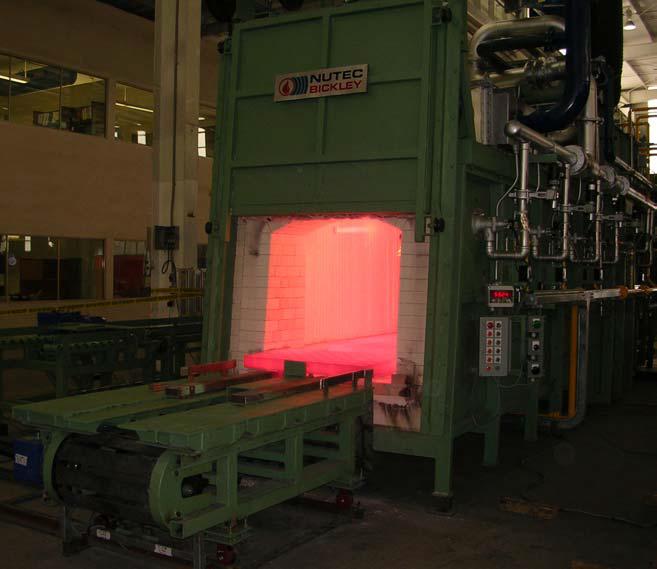
Furnaces
Generally, furnaces that operate at temperatures under 1000°F are called ovens.
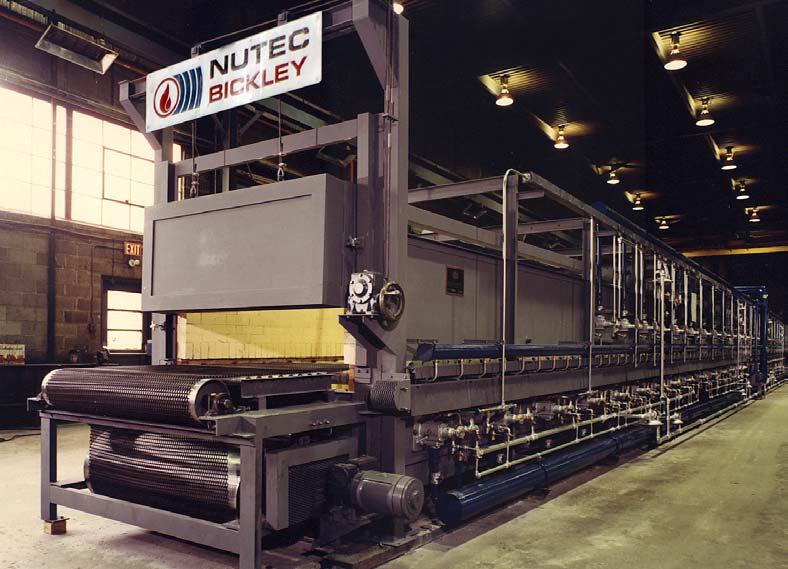
General Information
Furnaces and ovens have very similar features. Both are primarily used to heat treat metals, using gas, oil, or electricity.
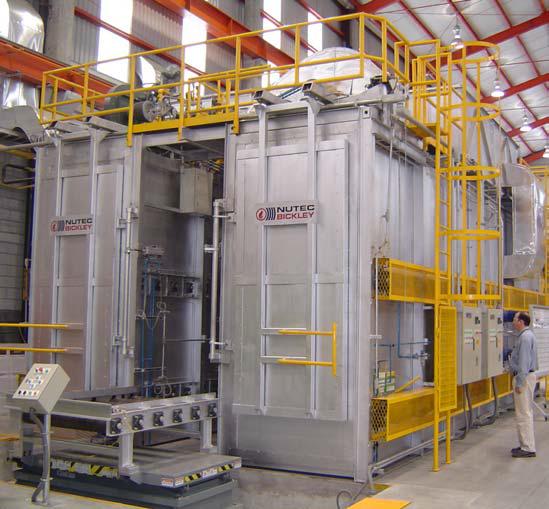
Equipment Design
Furnaces are usually made of either insulating firebrick or firebrick covered with refractory material. The charge, or inlet material, is introduced by chutes, conveyors, or pipes. The furnace can run in batch mode, shown here, or in continuous mode. The charge moves through the furnace on skids or rolls, or by gravity, rotation, slope, or mechanical pushers such as screws.
In a continuous furnace, the hearth may be stationary or rotary. Rotation speed can be adjusted based on the size, weight, and load of the charge. Open spaces beneath the hearth circulate air. Sidewalls support the arch-shaped roof.
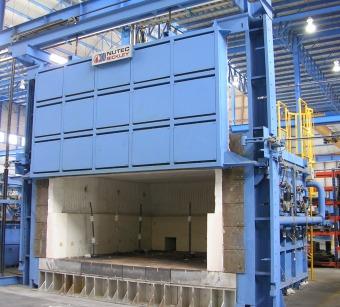
Heat in furnaces is generated by the combustion of fuel or conversion of electric energy. The furnace shown here uses the most common form, electric energy. Fuel and air enter via burners fired through burner tiles. Heat is transferred to the material by induction, conduction, convection, radiation, or a combination of them.
The products of fuel combustion exit through vents, flues, and a high-temperature stack, carrying with it some heat. To recover this heat, flue gases are used to preheat the stock or material being heated, the combustion air, or the fuel. The flue is located at the top or bottom, depending on whether the furnace is updraft or downdraft respectively.

Furnaces can be direct fired, over fired, under fired, or side fired. In direct fired furnaces, the heat is produced on the inside of the furnace chamber. In over, under, and side fired furnaces, heat is produced in a chamber in the respective area and flows throughout the furnace.

Below are some examples of furnaces.
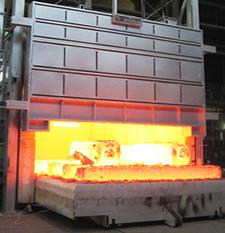
(Copyright Nutec Bickley, Santa Catarina, Mexico)
Car Bottom
In car bottom furnaces movable carts called cars move the charge through the furnace. To form a furnace hearth, the top of the car is refractory-lined, while the bottom is protected from the heat with brick, sand, and water seals. Heat is produced by burners along the sides of the furnace.
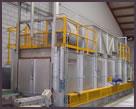
(Copyright Nutec Bickley, Santa Catarina, Mexico)
Roller Hearth
The picture on the left shows a roller hearth furnace used in continuous production. In rotary hearth furnaces, called Herreshoff furnaces, a vertical shaft supports multiple rotating hearths. The upper hearths make up the drying zone, where the material releases moisture to cool the gas. The charge exits at the bottom. An induced draft fan drives exhaust through the system, causing negative pressure.
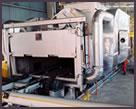
(Copyright Nutec Bickley, Santa Catarina, Mexico)
Conveyor
Another type of continuous furnace is a conveyor furnace. Depending on the product and process requirements the conveyor can be made from different materials such as a chain or a mesh belt. These can be used for multiple processes including curing, preheating, and tempering.

Forced-pit
In a forced-pit furnace, racks are located along the walls and a mesh-bottom basket fits inside the insulating brick and outer casing. Small particles fit inside the basket, while larger particles are placed on the racks. The electric coils are contained between the basket and insulating brick. Heated air is pushed up past the coils and down through the basket by a fan. Heat is produced by convection and radiation.

(Copyright Fisher Scientific, Pittsburgh, PA
Muffle
Muffle furnaces, or pot furnaces, are standard oven furnaces surrounded by housing. The combustion products flow around muffles, also called radiant tubes, which contain the charge material. Muffles protect the charge from the flames. If the muffles have no roof, they are called semi-muffles.
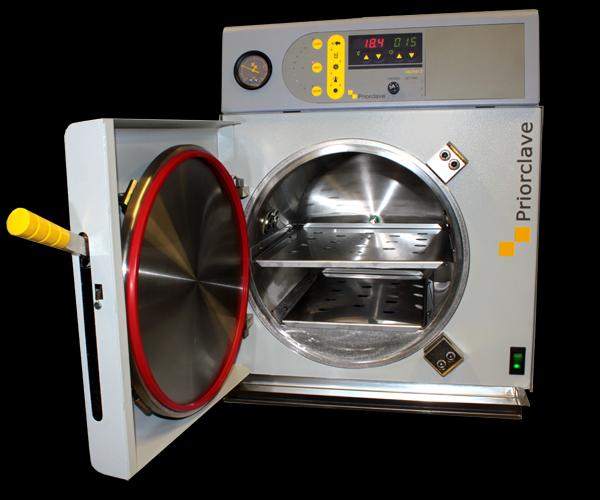
(Copyright Priorclave North America, Inc., Troy, MI)
Autoclave
Autoclaves are ovens that use steam for sterilization. Steam and compressed air are pumped into the chamber. Fans circulate the air and steam to facilitate even heating. After the contents have been held at the desired temperature for the designated amount of time, heat exchangers aid the fans in cooling the chamber. Smaller autoclaves, such as the lab scale autoclave pictured here, produce their own steam and do not use fans for circulation.
Usage Examples
Furnaces are primarily used to heat-treat metals. High temperatures soften, melt, and anneal the metals. Heating can also cause the absorption of carbon. Furnaces are used in various stages of heat treatment, as shown in the table below for steel treatment.
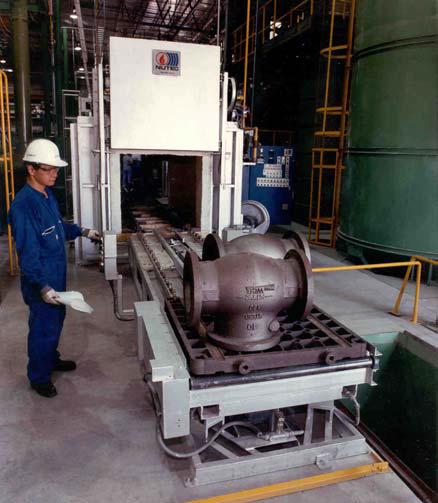
| Treatment | Temperature Range |
| Heat-Treating | up to 1200°F |
| Annealing | 1200-1600°F |
| Hardening | 1500-1600°F |
| Heating | up to 2300°F |
| Reheating | up to 2300°F |
Furnaces are also used to melt glass, coke coal, distill zinc, and many other processes. Hearth furnaces can be used to remove hazardous waste. They are also used in the microelectronics industry in semiconductor wafer production. Semiconductor ingots are grown within furnaces such as the one pictured below.
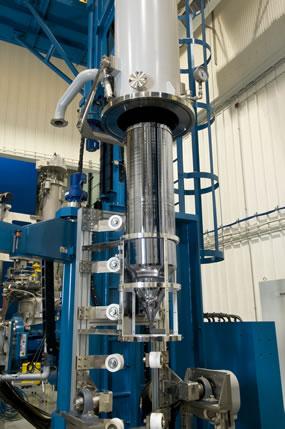
Autoclaves are used in the pharmaceutical and biotechnology industries to disinfect laboratory glassware and treat culture media, contaminated waste, liquids, and plasticware.

Advantages
- Can handle high temperatures.
- Durable construction.
- Flexible design.
Disadvantages
- Low fuel efficiency.
- Poor mixing.
- Dust from attrition.
- Heat loss.
- Liquid loss through the lining.
- Uneven heating.
- Burning, oxidizing, or decarburization of steel.
Kilns
General Information/Equipment Design
Kilns are furnaces used for ceramic or brick heating, causing moisture and organic materials to evaporate. Kilns are heated by horizontal space burners with gas, liquid, or solid fuel.
A rotary kiln is a cylindrical steel tube lined with insulating brick. The large ones can be as long as 760 feet with a diameter of 25 feet. The kiln turns on a horizontal axis at an angle of 2 to 3 percent to the horizontal.
Charge, or material to be heated, enters tunnel kilns on trays or trucks at one end, contacts the gas, and exits at the other end. The trays or trucks move on tracks or monorails. Heating is provided by reheat coils, and large propeller-type fans circulate the combustion gases. The picture below shows a tunnel kiln.
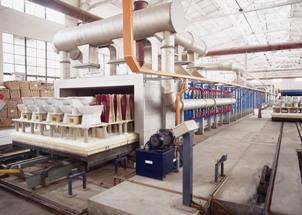
Usage Examples
Tunnel kilns are used to vitrify clay bricks, particulate solids, and large solid objects, such as the ones shown below. They are also used to sinter capacitors, soft ferrite, composite materials, and capacitors used in computers and cellular telephones also. Rotary kilns are used to make cement and to calcine small waste stones and free-flowing, granular solids. Downdraft kilns are used to produce brick, pipe, tile, and stoneware, while updraft kilns are used for pottery burning.


Acknowledgements
- Fisher Scientific, Pittsburgh, PA
- Nutec Bickley, Santa Catarina, Mexico
- Priorclave North America, Inc., Troy, MI
- Silfex, Incorporated, a Division of Lam Research
- Wisconsin Oven Corp., East Troy, WI
References
- Azbe, Victor. The Rotary Kiln: Its Performance Evaluation and Development. Azbe Corp. Saint Louis, Missouri. Print.
- Gilchrist, J. D. Fuels, Furnaces, and Refractories. Elmsford, New York: Pergamon Press, 1976. Print.
- Meyers, Robert A, ed. 2nd ed. Encyclopedia of Physical Science and Technology. Vol. 6 and 9. Orlando, Fl: Academic Press, 1987. Print.
- Perry, Robert H., and Don W. Green. Perry’s Chemical Engineers’ Handbook. 7th ed. New York: McGraw-Hill, 1997: 12-45 – 12-46, 12-49 – 12-51, 12-71, 12-73 – 12-75. Print.
- Pierret, Robert F. Semiconductor Fundamentals. 2nd ed. Reading, Massachusetts: Addison-Wesley Publishing Company, 1988. Print.
- Simpson, P.G. Induction Heating: Coil and System Design. New York: McGraw Hill Book Company, Inc., 1960. Print.
- Soldner, Paul. Kiln Construction. New York: American Craftsmen’s Council, 1965. Print.
- Trinks, W. Industrial Furnaces. vol. 1 New York: John Wiley & Sons, 1951. Print.
- Zinn, S. and S.L. Semiatin. Elements of Induction Heating: Design, Control, and Applications. Metals Park: ASM International, 1988. Print.
Developers
- Sujata Naik
- Julie Messacar
- Erica Mauter
- Kelsey Kaplan
- Keith Minbiole
- Henry Chen
